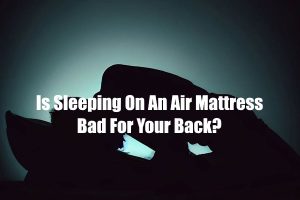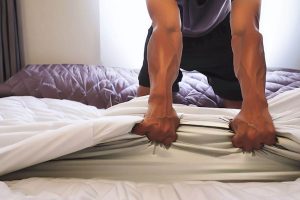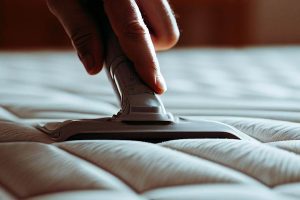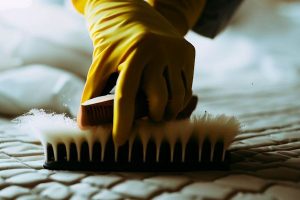Sleep is as vital as the air we breathe, and ensuring your mattress is properly protected is key to getting a good night’s rest.
Slipping beneath the covers with the knowledge that you’ve got a mattress protector guarding your mattress is like a warm hug – comforting and secure.
In this Nousdecor article, I’ll answer the question, ‘Do I Need A Mattress Protector?’, exploring the purpose and benefits, types, how to choose, care and cleaning, and more.
Key Takeaways
- A mattress protector can prevent allergies, asthma, and bed bugs by providing a barrier between allergens and the mattress.
- Using a mattress protector is a cost-effective way to protect the mattress from stains, damage, and extend its lifespan.
- Regular washing of the mattress protector ensures its effectiveness in keeping the bedding free of irritants.
- Choosing the right mattress protector based on mattress type, sleeper type, and specific needs (such as cooling features or bedbug protection) is important for optimal protection and comfort.

The Purpose and Benefits of a Mattress Protector
I’m sure you’ve heard the age-old saying that an ounce of prevention is worth a pound of cure.
When it comes to protecting your mattress, a mattress protector is the perfect way to prevent allergies, asthma, and bedbugs from ruining your sleep and your health.
Not only is it cost-effective, but it’s also designed to keep your mattress safe from stains or damage that can occur over time.
Investing in a mattress protector is one of the simplest and most effective ways to ensure a good night’s sleep and a healthier feel life guide for sleepers.
Preventing Allergies
You may want to consider getting a mattress protector to prevent allergies. A mattress protector can protect your mattress from dustmites, bed bugs, and other allergens. It can also help prevent a memory foam mattress from wearing down quickly.
Some mattress protectors are quilted, while others are encased in a fitted sheet. To ensure that it’s effective, be sure to wash your mattress protector regularly.
Here are some of the benefits of using a mattress protector:
- Bed bugs are repelled by mattress protectors
- Mattress pads provide a barrier between allergens and the mattress
- Dust mites are prevented from entering the mattress
Mattress protectors are a great way to keep you and your family safe and healthy. With the right mattress protector, you can keep your bedding free of allergens and other irritants. A mattress protector can also extend the life of your mattress and keep it looking newer for longer.
Transitioning into the subsequent section about ‘preventing asthma’, it is important to consider the air quality of the environment and the materials used in your bedding.
Preventing Asthma
To help prevent asthma, it’s important to consider the air quality of your environment and the materials used in your bedding.
A mattress protector, mattress cover, or mattress toppers can be a great way to provide an extra layer of protection. Having a waterproof layer will help reduce allergens and dustmites. A foam mattress topper can also provide extra comfort and protection.
Make sure to also cover your pillows and bed sheets with a layer of protection. Investing in a mattress protector can help provide a layer of comfort and protection, ensuring that you can sleep peacefully without worrying about asthma-causing allergens.
To further protect your bedding, consider investing in a mattress cover or foam topper to provide an extra layer of protection.
Preventing Bed Bugs
You can help prevent bed bugs by investing in a waterproof mattress cover or foam topper.
Investing in a mattress protector can provide a variety of benefits, such as:
- Protecting your mattress from dustmites and other allergens
- Extending the warranty of your mattress
- Keeping your mattress sheets clean and safe
Adding a mattress pads or foam topper is also an effective way to protect your mattress from bed bugs. Not only is this cost-effective, but it can also help you sleep more comfortably.
Transitioning to the next section, investing in a mattress protector is an easy way to save money and protect your mattress from bed bugs.
It’s Cost Effective
Investing in a mattress protector can be cost effective. You don’t need to splurge to get the best mattress protector. For a fraction of the cost of a new mattress, you can buy a waterproof mattress protector that will protect your bed from spills, sweat, and other forms of damage.
You can even buy a protector that will fit snugly over your mattress, bed frame, and box spring. Plus, you can wash your protector in a machine, making it easy to maintain.
With a mattress protector, you can ensure that your mattress will last for years, and you’ll get the best sleep possible, with the best protection. Investing in a mattress protector is one of the best investments you can make for your mattress – and your sleep.
With the right mattress protector, you can rest assured that your mattress is protected and that you’re getting the best mattress protection for your money.

Types of Mattress Protectors
There are several types of best mattress protectors to choose from, so it’s important to consider your needs before making a decision. Here are some of the most popular options:
- Pad – A thin protector that sits on top of your mattress. It can be easily washed and is ideal for those who don’t need protection from fluids.
- Pad vs. Casper Mattress – A thicker protector that is designed to fit over your mattress. You can wash it or buy a cover that can be washed.
- Hybrid – A combination of a pad and a best mattress protector. It can provide both comfort and protection from liquids.
No matter which type of mattress protector you choose, you’ll want to make sure to read reviews and determine if it will fit your Casper mattress or other mattress type. You’ll also want to consider cooling features and how often you can wash the protector. If you have pillows, you’ll want to make sure the protector you choose is compatible with them as well.
Choosing the right mattress protector can help ensure that your mattress stays clean and comfortable for years to come.
Making the right choice when it comes to mattress protectors is important, as it can help you get the most out of your mattress. Knowing the types of mattress protectors and their features can help you make an informed decision.
Do I Need A Mattress Protector?
Deciding whether to invest in a mattress protector is an important decision. With so many mattress types, accessories, and toppers available, it can be hard to know which is the best for you.
To make sure your new bed is protected, it’s good to look into mattress protectors. They come in a variety of styles, and some even add a little extra comfort. Ultimately, mattress protectors will help you to keep your mattress in its best condition and make it last longer. And that’s a great feeling!
How to Choose the Right Mattress Protector
Now that you know why you need a mattress protector, it’s time to learn how to choose the right one. There are many factors to consider when selecting the best mattress protector for your needs. Here are a few tips:
- Consider the type of sleeper you are and the type of mattress you have. If you have a memory foam mattress, you should look for a protector specifically designed for it. If you have a cooling mattress, look for a protector with breathable materials.
- Make sure you get the right size. Measure your mattress before you purchase a mattress protector to ensure you get the right fit.
- Research the best mattress-protecting cover brands. Look for one with a good balance of firm and plush material, as well as any bed bug concerns.
By researching your options and considering your specific needs, you can find the best mattress-protecting cover for your new mattress. With the right mattress-protecting cover, you can be sure to get the most out of your sleep.
Now, let’s move on to caring and cleaning your mattress-protecting cover.
Care and Cleaning of a Mattress Protector
Caring for and cleaning your mattress-protecting cover is essential to ensure it lasts. Investing in the best mattress-protecting covers and considering warm air mattress camping tips can help securing split king mattresses.
Flea-proof your mattress with protectors to prevent sheet slipping on air mattress and constant air loss in air mattress reasons. Bed bug concerns with foam mattress can be addressed by considering what is the difference between a firm and plush mattress.
Dead skin and other terms should always be kept in mind when cleaning and caring for mattress-protecting covers. These steps are essential for keeping your mattress-protecting cover in the best condition and transitioning into the common myths surrounding mattress-protecting covers.
Common Myths Surrounding Mattress Protectors
There are many misconceptions about mattress-protecting covers, so let’s debunk some of them.
- People think they’re not necessary – Wrong! A mattress-protecting cover provides an extra layer of protection against spills, dustmites, and allergens.
- People believe they prevent sheets from slipping on an air mattress – Nope! Mattress protectors don’t prevent sheets from slipping on an air mattress.
- People say the best mattress-protecting covers are expensive – Not true! You can find quality mattress-protecting covers at an affordable price.
Knowing the truth about mattress-protecting covers helps you make an informed decision about whether or not to invest in one. And the cost of investing in a mattress-protecting cover is worth it for the peace of mind it brings.

The Cost of Investing in a Mattress Protector
Investing in a mattress-protecting cover can be cost-effective and bring peace of mind. With the average mattress costing between $500 and $1,500, purchasing an additional mattress-protecting cover is a relatively small expense.
Even the most expensive protectors are typically $100 or less. When you consider the cost of replacing a mattress due to stains, spills, or wear and tear, the purchase of a protector is a wise decision.
Not only will a protector keep your mattress looking like new, but it will also create a barrier against allergens, dust mites, and other irritants that can affect sleep quality. It’s an investment that will pay off in the long run, and provide you with a healthier, more comfortable night’s sleep.
Transition: Common mistakes to avoid when using a mattress-protecting cover.
Common Mistakes to Avoid when Using a Mattress Protector
Using a mattress-protecting cover isn’t always as easy as it seems, so there are a few mistakes to avoid in order to ensure it lasts.
One mistake is failing to regularly clean the protector. Dirt and dust can build up and cause friction, which can wear away the fabric over time.
Another mistake is leaving it on while laundering your mattresses. This can trap heat and moisture, potentially leading to mold or mildew.
Additionally, using bleach when laundering can be damaging to the protector’s fabric. It’s important to be mindful of all these potential pitfalls when using a mattress-protecting cover. Doing so will help it last longer and keep your mattress safe.
Transitioning to the next section, understanding when it’s time to replace your mattress-protecting cover is just as important.
Signs That It’s Time to Replace Your Mattress Protector
It’s important to know when it’s time to replace your mattress-protecting cover. If it’s no longer waterproof, has rips or tears, or a foul smell, then it’s time to get a new one.
When you notice any of these signs, it’s time to invest in a new protector to keep your mattress safe and clean. It should be waterproof and breathable to keep your mattress free of sweat and other liquids. If the protector is thin or worn, it won’t be able to keep your mattress safe from dust mites, allergens, and bedbugs.
Over time, the protector will start to show signs of wear, which can be detected by rips, tears, or a decrease in waterproofness. If you notice any of these signs, it’s time for a replacement. Also, if you notice any unpleasant odors coming from your mattress-protecting cover, it’s a good sign that it’s time for a replacement.
Keeping your mattress protected is an essential part of maintaining a good night’s sleep.
Frequently Asked Questions
Conclusion
Wrapping up, investing in a mattress-protecting cover can be a great way to ensure a good night’s sleep and extend the life of your mattress.
With the right type of mattress protector, you can be sure you’re protected from dustmites, allergens, and liquids. Plus, with the right care and cleaning, your mattress protector will last.
So, don’t be afraid to take the plunge and invest in a mattress protector – you won’t regret it.






